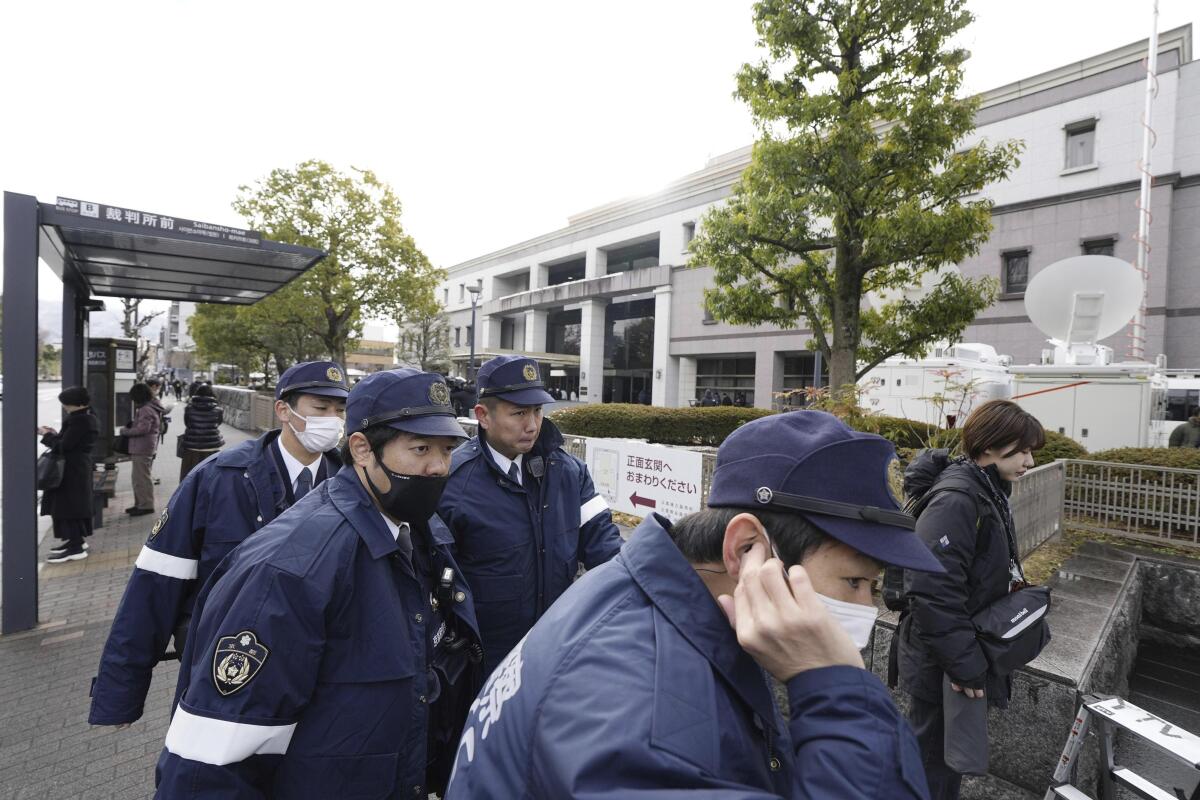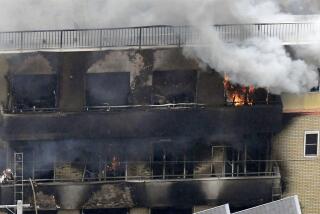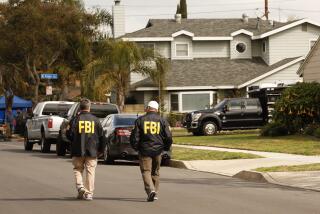Man sentenced to death for arson attack at Japanese anime studio that killed 36

- Share via
TOKYO — A court sentenced a man to death Thursday after finding him guilty of murder and other crimes in a shocking arson attack on an anime studio in Kyoto, Japan, that killed 36 people.
The Kyoto District Court said it found Shinji Aoba mentally competent to face punishment for the crimes and announced the death sentence after a recess in a two-part session Thursday.
Aoba stormed into Kyoto Animation’s No. 1 studio July 18, 2019, and set it on fire. Many of the victims were believed to have died of carbon monoxide poisoning. More than 30 other people were badly burned or injured.
Judge Keisuke Masuda said Aoba had wanted to be a novelist but was unsuccessful and sought revenge, believing that Kyoto Animation had stolen novels he submitted as part of a company contest, according to NHK national television.
NHK also reported that Aoba, who was out of work and struggling financially after repeatedly changing jobs, had plotted a separate attack on a train station north of Tokyo a month before the fire at the animation studio.
Aoba plotted the attacks after studying past criminal cases involving arson, the court said in the ruling, noting the process showed that Aoba had premeditated the crime and was mentally capable.
“The attack that instantly turned the studio into hell and took the precious lives of 36 people caused them indescribable pain,” the judge said, according to NHK. During the trial, Aoba told the victims’ families that he was sorry, but he did not show sincere regret or face their sufferings fully and there was little hope for correction, the ruling said.
Aoba, 45, was severely burned and was hospitalized for 10 months before his arrest in May 2020. He appeared in court in a wheelchair.
Aoba’s lawyers argued that he was mentally unfit to be held criminally responsible.
About 70 people were working inside the studio in southern Kyoto, Japan’s ancient capital, at the time of the attack. One of the survivors said he saw a black cloud rising from downstairs, then felt scorching heat and jumped out of a window of the three-story building gasping for air.
Some survivors have been pulled from beneath flattened buildings days after a magnitude 7.6 quake rattled the western Japanese coast.
The company, founded in 1981 and better known as KyoAni, made a mega-hit anime series about high school girls, and the studio trained aspirants to the craft.
Japanese media have described Aoba as being thought of as a troublemaker who repeatedly changed contract jobs and apartments and quarreled with neighbors.
The fire was Japan’s deadliest since 2001, when a blaze in Tokyo’s congested Kabukicho entertainment district killed 44 people, and it was the country’s worst-known case of arson in modern times.
Chief Cabinet Secretary Yoshimasa Hayashi said the Kyoto Animation attack was “a highly tragic case” and that the government has since stepped up restrictions on gasoline sales, including mandatory identification checks of purchasers. Hayashi declined to comment on the death penalty ruling.
Start your day right
Sign up for Essential California for the L.A. Times biggest news, features and recommendations in your inbox six days a week.
You may occasionally receive promotional content from the Los Angeles Times.
Japan has maintained the death penalty despite growing international criticism. Justice Ministry officials say it is a justified response to heinous and violent crimes. A survey by the Japanese government showed an overwhelming majority of the public supports capital punishment.
Executions are carried out in high secrecy in Japan, where prisoners are not informed of their fate until the morning they are hanged. Since 2007, Japan has begun disclosing the names of those executed and some details of their crimes, but disclosures are still limited.
More to Read
Sign up for Essential California
The most important California stories and recommendations in your inbox every morning.
You may occasionally receive promotional content from the Los Angeles Times.















